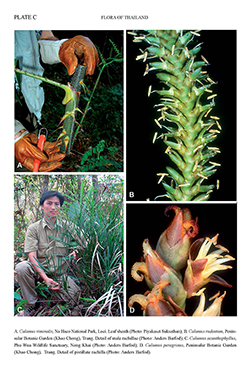e-Flora of Thailand
Volume 11 > Part 3 > Year 2013 > Page 376 > Arecaceae > Calamus
38. Calamus rudentum Lour.wfo-0000759895
Fl. Cochinch. 1: 209. 1790; Evans et al., A Field Guide to the Rattans of Lao PDR: 56. 2001.— Palmijuncus rudentum (Lour.) Kuntze, Revis. Gen. Pl. 2: 732. 1891.— Rotang rudentum (Lour.) Baill., Hist. Pl. 13: 299. 1895. Plate C: B.
Accepted Name : This is currently accepted.
Description : Very robust clustering rattan. Stem climbing to 75 m, usually less, without sheaths 2.5–3.5 cm diam., with sheaths 4–7 cm diam.; internodes to 30 cm or more long. Leaf ecirrate; sheaths tending to split deeply opposite the petiole, light to yellowish-green, very densely armed with a wide range of different sized spines, including large reflexed flattened reddish-brown spines to 5 cm long borne in oblique partial whorls, particularly below the petiole, and much smaller black needle-like spines to 0.5 cm long, also borne in short partial whorls, and scattered ungrouped spines, and particularly large erect pale brown flattened spines to 15 cm long, borne around the leaf sheath mouth; knee inconspicuous, not greatly swollen and almost entirely obscured by the sheath spines; ocrea inconspicuous; flagellum massive, to 6 m or more long; petiole 20–60 cm long, densely armed with partial whorls of spines as on the leaf sheath; rachis to 3.5 m long, bearing regularly arranged, close, linear-lanceolate leaflets, the largest to 45–65 by 1.5–2.5 cm, with robust bristles at least 1 cm long on the adaxial and abaxial surfaces of the main vein, the margins also bristly. Inflorescences male and female superficially similar, the male branching to 3 orders, the female to 2 orders, to 6.5 m long including the long terminal flagellum with up to 8 or more well spaced pendulous partial inflorescences, each up to 1.5 m long; male rachillae to 20 by 0.2–0.3 cm; female rachillae 12–35 by 0.3–0.4 cm. Mature fruit ovoid, ca 1.8 by 1.2 cm, covered in 13 vertical rows of yellowish-brown deeply channelled scales with thin dark margins. Seed globose ca 0.9 cm diam.; endosperm homogeneous. Seedling leaf with 4–6 linear leaflets.
Thailand : NORTHERN: Nakhon Sawan; EASTERN: Nakhon Ratchasima; CENTRAL: Nakhon Nayok; SOUTH-EASTERN: Chon Buri, Chanthaburi; PENINSULAR: Surat Thani, Nakhon Si Thammarat, Trang.
Distribution : Cambodia, Laos, Vietnam (type).
Ecology : On slopes in evergreen forests, to 500 m alt.
Vernacular : Wai yae (หวายแย้), wai pong (หวายโป่ง); wai khi sian (หวายขี้เสี้ยน)(Peninsular).
Uses: Handicrafts, edible shoot and fruits.
Conservation Status: Not threatened.
Notes: This is a very robust flagellate species with immensely long inflorescences and robust leaves with many regularly arranged leaflets.

